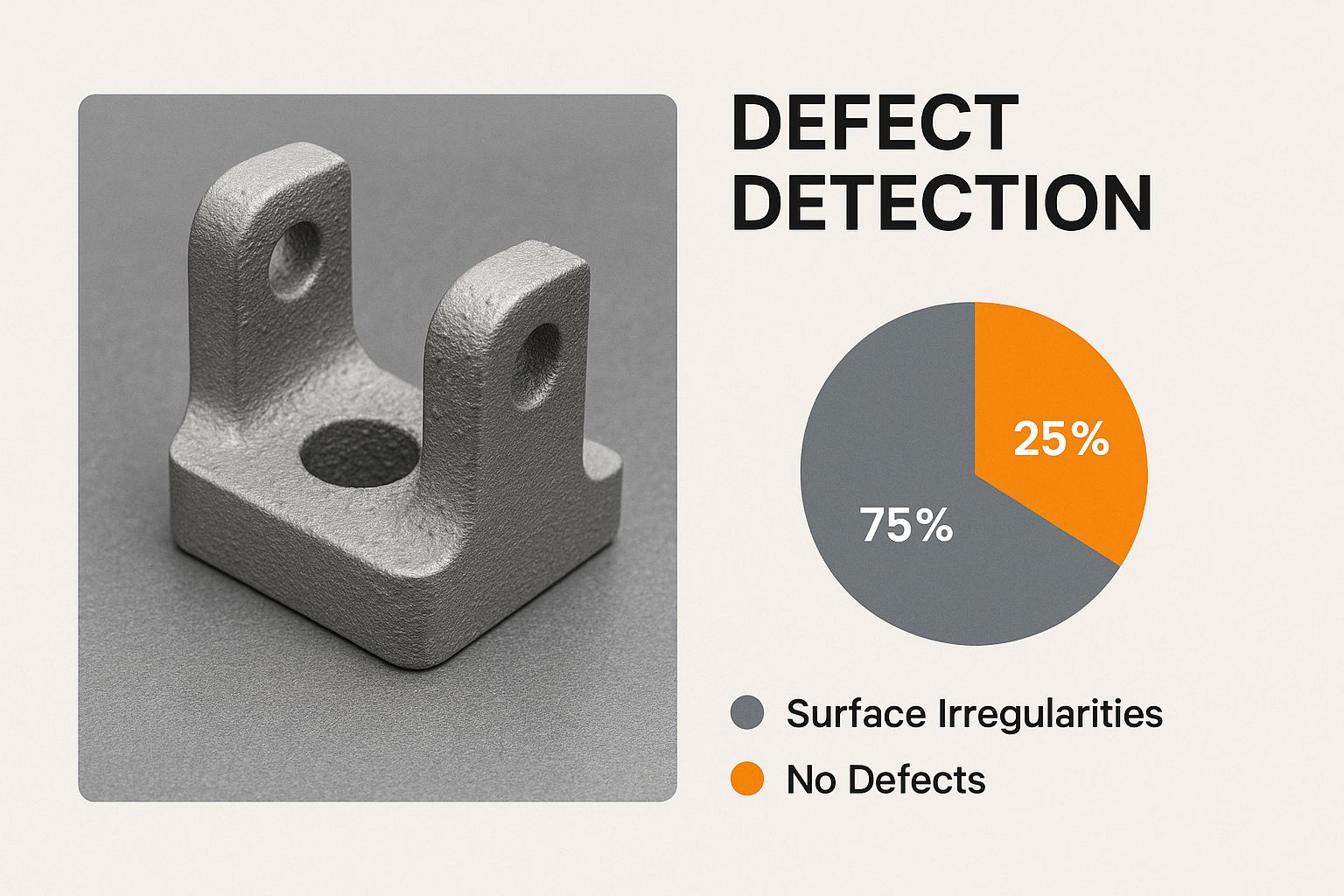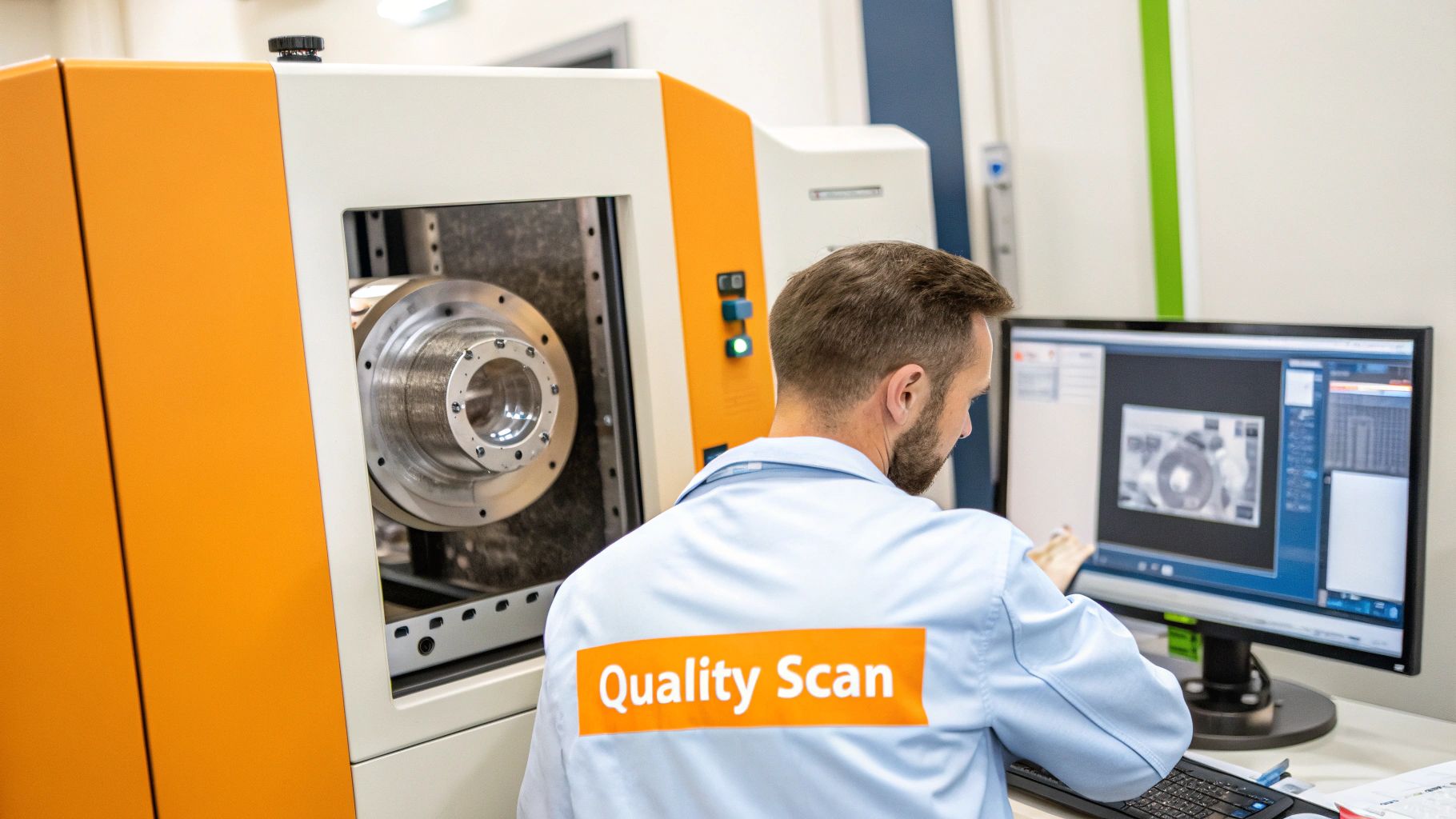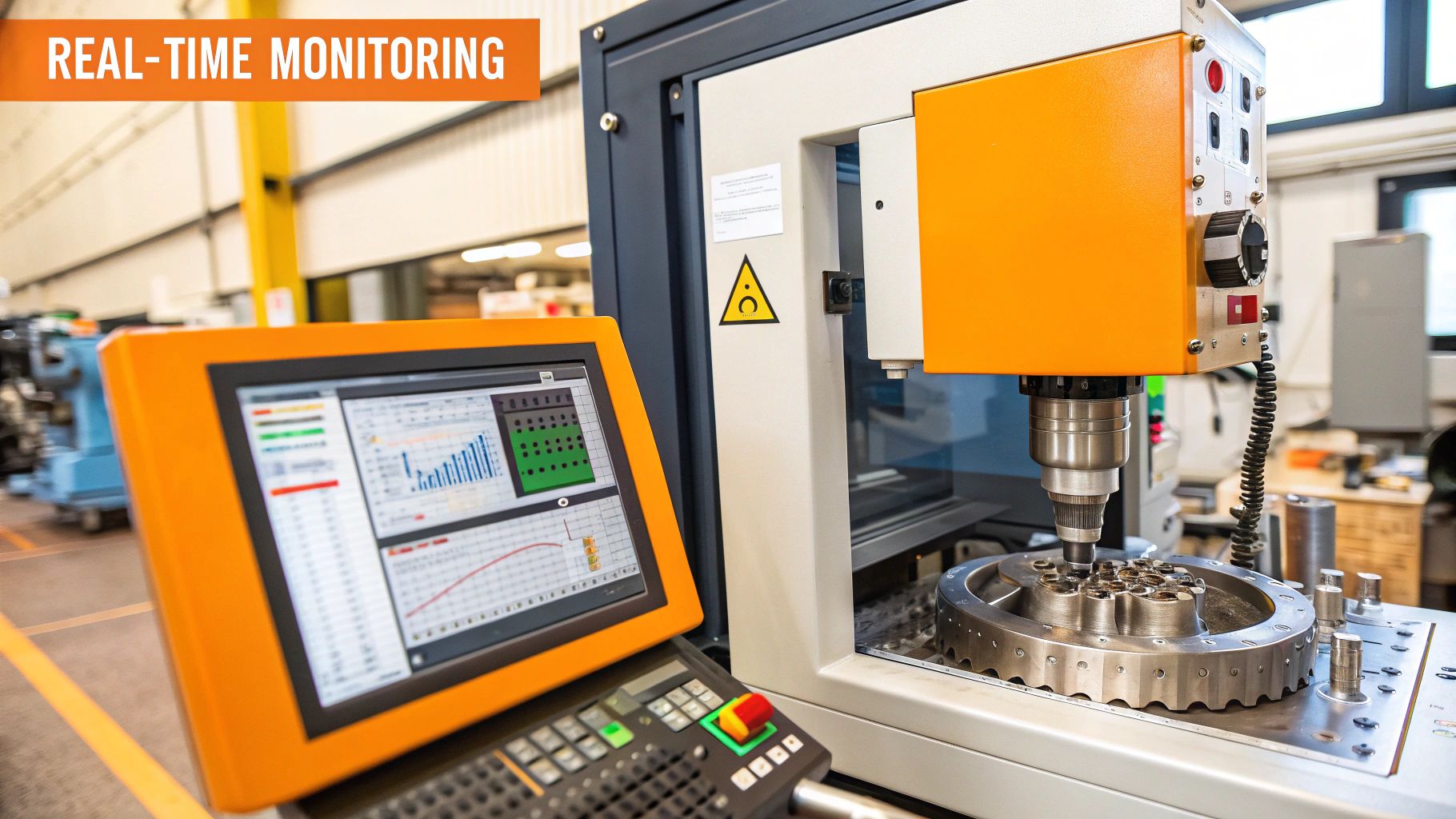Navigating Today's Metal AM Quality Control Challenges
Metal Additive Manufacturing (AM) offers exciting possibilities for creating complex designs and on-demand production. However, ensuring consistent quality remains a significant challenge. Process variability, such as fluctuations in laser power, scan speed, or powder distribution, can introduce inconsistencies within a single build. Furthermore, inconsistent material performance, stemming from variations in powder quality or composition, can amplify these issues.
These inconsistencies have serious implications, especially in demanding applications like aerospace, medical devices, and defense, where part failure is simply not an option. Imagine a turbine blade produced with metal AM. Even slight variations during the build can result in internal defects like porosity or cracking. These flaws compromise the blade's structural integrity, potentially leading to catastrophic engine failure. This demand for absolute reliability highlights the vital importance of robust quality control in metal AM.
This challenge isn't just theoretical. A 2017 study published in the Journal of Manufacturing and Materials Processing revealed that 92% of industry professionals cited inconsistent product quality in batch production, primarily due to process variability and material inconsistencies. The study emphasizes the urgent need for standardized quality control measures, particularly in powder quality management and defect detection, to satisfy stringent regulations and customer expectations.
Overcoming Quality Inconsistencies: A Multi-Faceted Approach
Tackling these quality control challenges requires a comprehensive approach that spans multiple stages of the metal AM workflow. This involves shifting from reactive, post-build inspection to a proactive, in-process monitoring strategy.
-
Powder Quality Management: Implementing strict powder characterization and handling procedures is essential. This includes analyzing particle size distribution, morphology, and chemical composition to ensure batch-to-batch consistency.
-
Real-Time Monitoring: Integrating sensors and monitoring systems into the AM process allows for immediate detection of deviations from desired parameters. This enables real-time adjustments, preventing defects from spreading throughout the build.
-
Advanced Non-Destructive Testing (NDT): Utilizing techniques like Computed Tomography (CT) scanning enables the detection of internal defects that traditional surface inspections would miss.
-
Data Analysis and AI: Harnessing the power of data analytics and Artificial Intelligence (AI) can help identify patterns and correlations between process parameters and the final part quality. This information can then be used to refine build parameters and predict potential defects.
Implementing these strategies is crucial for guaranteeing the reliability and repeatability of metal AM processes. By adopting a proactive quality control approach, the industry can fully realize the potential of this technology and pave the way for its broader adoption across diverse sectors.
Breaking Through Limitations: Advanced NDT for Metal AM
Traditional inspection methods often struggle with the complex geometries and unique defect characteristics found in metal additive manufacturing (AM) parts. This has created a need for advanced Non-Destructive Testing (NDT) techniques specifically designed for the complexities of AM. Leading manufacturers are adopting multi-modal inspection strategies, combining powerful tools like computed tomography (CT), ultrasonic testing (UT), X-ray diffraction, and thermography. These technologies provide a comprehensive understanding of part integrity, from microscopic surface flaws to hidden internal voids, pushing the boundaries of quality control.
Combining Strengths: Multi-Modal Inspection
Using a combination of NDT methods gives a more complete picture of a part's integrity than relying on just one technique. For instance, while CT scanning excels at revealing internal structures and voids, UT is better at detecting cracks and delaminations that CT might miss. This synergy is vital for ensuring the reliability of complex AM parts.
X-ray diffraction analyzes the material's crystallographic structure, providing key data on residual stresses and potential weaknesses. Thermography offers a fast way to detect surface and near-surface defects by identifying variations in thermal conductivity.
To better understand the capabilities, costs, and limitations of these methods, let's examine the following comparison:
Comparison of Non-Destructive Testing Methods for Metal AM Parts This table compares different NDT methods by capability, cost, and limitations for metal AM quality inspection.
| NDT Method | Defect Types Detected | Inspection Speed | Relative Cost | Limitations |
|---|---|---|---|---|
| Computed Tomography (CT) | Porosity, voids, inclusions, internal features | Moderate | High | Part size limitations, material density dependence |
| Ultrasonic Testing (UT) | Cracks, delaminations, lack of fusion | Fast | Medium | Requires skilled operators, complex geometry challenges |
| X-ray Diffraction | Residual stress, crystallographic structure | Slow | High | Surface analysis only, limited defect detection |
| Thermography | Surface cracks, subsurface defects | Very Fast | Low | Limited depth penetration, sensitivity to environmental factors |
This table highlights the strengths and weaknesses of each NDT method, reinforcing the need for a multi-modal approach. Combining these methods allows manufacturers to address the limitations of individual techniques.
Implementation in Real-World Production
Production teams are integrating these advanced NDT methods into their workflows. Take, for example, a complex aerospace component with internal channels impossible to inspect with traditional methods. CT scanning allows for complete internal visualization, ensuring the part meets stringent requirements. This significantly improves upon older methods, which often necessitated destructive testing to verify internal integrity. The data generated by these inspections can even be used to optimize the AM process, further improving quality and reducing waste. You might be interested in: How to master...
Visualizing NDT Effectiveness
Industry surveys show a significant move towards advanced NDT. Over 90% of aerospace and medical manufacturers now require CT scanning for internal geometry validation in critical metal AM components. Traditional surface-based inspections miss up to 40% of subsurface defects in laser powder bed fusion parts, making this shift unsurprising. This trend also shows increased adoption of AI-powered digital twins, up 35% since 2023, for predictive quality adjustments before printing. Learn more about additive manufacturing metrology in 2025 and beyond here.
The following data chart illustrates the effectiveness of different NDT methods in detecting specific defect types in metal AM parts:

- Porosity: CT scanning shows the highest detection rate.
- Cracks: UT exhibits superior performance.
- Lack of Fusion: While both CT and UT can detect it, UT is generally more sensitive.
- Surface Roughness: Surface profilometry and optical microscopy provide the best results.
As the chart illustrates, each NDT method has its strengths. Using a multi-modal approach is crucial for a comprehensive quality inspection of metal AM parts. By strategically combining these techniques, manufacturers can effectively identify a wider range of defects, ensuring the production of high-quality, reliable parts.
The AI Revolution in Metal AM Quality Assurance
Artificial intelligence (AI) is transforming quality assurance in metal additive manufacturing (AM). This evolution introduces powerful new possibilities, like predicting defects in real-time and using adaptive process controls that learn and improve. This isn't just automating current processes; it's a fundamental shift in how we ensure quality in metal AM.
AI-Powered Defect Recognition
Leading manufacturers are now training AI models to detect subtle patterns in sensor data, thermal images, and acoustic signals – patterns that human operators might overlook. For example, an AI model can learn from thousands of images of both successful and flawed builds. It learns to distinguish between acceptable and unacceptable variations in the melt pool, powder bed, or finished part. This allows for automatic, real-time detection of potential defects during the build. More information is available on laser-podcast.com.
Digital Twins and Predictive Quality
Digital twin technology creates a virtual replica of the AM process. These virtual models allow for simulation-based quality prediction, enabling manufacturers to spot potential problems before they happen in the real world. This proactive approach lets manufacturers adjust parameters and prevent defects, reducing material waste and rework. It marks a significant shift from reactive to proactive quality management.
Tangible Results: Increased Efficiency and Reduced Costs
The global additive manufacturing market, valued at $21.58 billion in 2024, is projected to reach $25.92 billion in 2025, with North America holding a substantial market share. Maintaining quality control amidst this rapid expansion presents a challenge. Advanced metrology tools, such as AI-enhanced digital twins and real-time laser scanners, are becoming crucial for minimizing material waste and rework. These advancements support the predicted 19.29% compound annual growth rate (CAGR) through 2034, especially in aerospace applications using titanium and nickel alloys. More statistics are available from Precedence Research.
These AI-driven methods deliver significant, measurable improvements. They result in less material waste, reduced rework, and substantially higher first-time-right production rates. These gains translate directly into cost savings and increased profits, demonstrating the clear value of AI in metal AM quality assurance. Ultimately, AI helps businesses produce better parts more efficiently.

Real-Time Quality Monitoring That Actually Works
Gone are the days of discovering defects after a metal additive manufacturing (AM) build is complete. Now, advanced monitoring systems are changing how we approach metal AM by tracking key quality metrics as the part is being built. This provides remarkable insights into the process as it happens. This real-time approach allows for quick adjustments, stopping minor issues from escalating into significant problems.

Multi-Dimensional Data Streams for In-Process Control
Industry leaders are using multiple sensors to gather comprehensive data streams. High-speed cameras capture images of the melt pool and powder bed, while infrared sensors monitor temperature variations. Acoustic sensors listen for subtle shifts in the process, and laser profilometers measure the layer-by-layer growth, maintaining dimensional accuracy. Combining this data provides a thorough understanding of the melt pool dynamics and layer formation.
For instance, a sudden increase in acoustic emissions might indicate a spatter event. A change in the melt pool temperature could point to an issue with laser power absorption. Access to this real-time data empowers operators to immediately adjust parameters such as laser power or scan speed. This proactive approach prevents flaws from spreading throughout the build.
To better understand the key parameters and their impact, let's explore the following table. It summarizes the crucial process parameters that are monitored in metal AM production, along with their monitoring methods, impact on quality, and typical acceptable ranges.
Key Process Parameters Monitored in Metal AM Production
| Process Parameter | Monitoring Method | Impact on Quality | Typical Acceptable Range |
|---|---|---|---|
| Melt Pool Temperature | Infrared Camera | Porosity, Lack of Fusion | Dependent on material (e.g., 1500-1700°C for Ti6Al4V) |
| Powder Bed Temperature | Infrared Camera | Residual Stress, Warping | Dependent on material (e.g., 80-120°C for Ti6Al4V) |
| Acoustic Emissions | Acoustic Sensors | Spatter, Cracking | < Threshold based on historical data and material |
| Layer Height | Laser Profilometer | Dimensional Accuracy, Surface Finish | +/- 0.05 mm |
| Melt Pool Size & Shape | High-Speed Camera | Porosity, Lack of Fusion | Dependent on laser power and scan speed |
| Laser Power | Power Meter | Melt Pool Dynamics, Penetration Depth | +/- 5% of target power |
| Scan Speed | Galvanometer System | Melt Pool Size, Heat Input | +/- 2% of target speed |
This table highlights the interconnectedness of process parameters and their influence on the final part quality. By carefully monitoring these parameters, we can ensure optimal build conditions.
Implementing Effective Monitoring Systems
Creating effective monitoring systems requires attention to several key aspects. Choosing the right sensors is fundamental. Each sensor is designed for specific data points, so selecting the correct mix for your metal AM process is paramount. Setting suitable alert thresholds is equally important. Overly sensitive thresholds trigger unnecessary alarms, while thresholds that are too relaxed could miss real problems.
- Sensor Selection: Select sensors based on the metal AM process and the potential defects you need to address.
- Alert Thresholds: Define specific thresholds for each monitored parameter to generate timely alerts.
- Operator Training: Equip operators with the knowledge to interpret data and make informed adjustments based on the real-time feedback.
This training equips operators to understand complex data signals and translate real-time information into corrective actions. This proactive approach can prevent significant quality issues and improve part consistency.
Case Studies: Real-World Impact of Real-Time Monitoring
Real-time monitoring has shown substantial benefits in real-world settings. One study demonstrated that real-time monitoring, using high-speed cameras and thermal imaging, decreased porosity in titanium alloy components by 80%. In another instance, acoustic monitoring allowed for the early detection of inconsistent powder flow, preventing a build failure. This saved substantial material and production time.
These systems empower operators to make immediate parameter changes that weren't possible with traditional post-build inspections. By identifying and resolving problems in real-time, manufacturers can significantly enhance part quality, minimize material waste, and boost overall production efficiency. This proactive strategy is key to elevating metal additive manufacturing quality control and encouraging greater adoption of the technology.
Navigating the Standards Maze for Metal AM Certification
The world of metal additive manufacturing (AM) is constantly changing, bringing a growing need for reliable quality inspection standards. This creates both exciting possibilities and important considerations for manufacturers. This section explores the crucial frameworks developed by organizations like ASTM, ISO, and SAE, along with specific industry groups, to help ensure quality and consistency in metal AM.
Decoding Key Standards for Metal AM
Understanding the relevant standards for material properties, process validation, and qualification procedures is essential for success in metal AM. These standards address several key areas:
-
Material Properties: Standards define the acceptable characteristics of metal powders, including chemical composition, particle size, and flowability. This helps ensure consistent material performance and reliable parts.
-
Process Validation: These standards outline procedures for qualifying AM processes, like laser power, scan speed, and layer thickness. This leads to repeatable and predictable results, minimizing variations in part quality.
-
Qualification Procedures: Standards detail requirements for personnel, equipment, and documentation to maintain consistent production quality. This also ensures compliance with regulatory guidelines.
For example, the ASTM F3308 standard offers guidance on qualifying laser powder bed fusion processes for titanium alloys. It outlines the requirements for process parameter development, testing, and documentation, helping manufacturers create dependable production processes.
Integrating Standards Into Quality Systems
Leading manufacturers are incorporating these standards into their quality systems. This typically involves creating detailed documentation, implementing robust traceability systems, and getting ready for certification audits. Balancing these requirements with ongoing innovation can be a challenge. For more insights, check out this resource: How to master...
Companies are finding efficient ways to streamline these processes. Some are using digital platforms to manage documentation and traceability, while others are incorporating automated quality control checks throughout their AM workflow. These strategies lessen the administrative burden while ensuring compliance.
Practical Guidance for Certification Audits
Preparing for certification audits doesn’t have to be overwhelming. By approaching the process step by step, companies can effectively address each requirement:
-
Documentation: Create clear and concise documentation of processes, materials, and inspection results. This gives auditors the necessary evidence of compliance and traceability.
-
Traceability: Implement a system for tracking materials and parts through the entire AM process. This helps pinpoint the source of any problems and ensures accountability.
-
Training: Invest in training for personnel on the relevant standards and quality procedures. This guarantees everyone understands their responsibilities in maintaining quality and compliance.
Successfully navigating these standards isn’t just about checking boxes; it’s about establishing trust. By demonstrating a commitment to quality and consistency, metal AM manufacturers can access new markets and explore innovative applications. As the industry grows, adhering to standards will be essential for building confidence and encouraging broader use of metal AM technologies.
Building Your Complete Metal AM Quality Strategy Playbook
A robust quality strategy is essential for unlocking the full potential of metal additive manufacturing (AM). This section provides a practical roadmap for building a comprehensive quality system. It covers the entire metal AM workflow, from validating incoming powder to verifying the final part. This isn't a universal solution, but a flexible framework you can adapt to your specific production requirements.
Establishing a Foundation: Incoming Powder Validation
High-quality metal AM parts start with the raw material: metal powder. A strong powder quality management system is vital. This means carefully characterizing each powder batch, analyzing properties like particle size distribution, morphology, and chemical composition. This ensures consistency between batches and sets the stage for predictable and repeatable builds.
In-Process Monitoring: Catching Defects Early
Real-time monitoring is essential for efficient metal AM quality control. Integrating sensors like high-speed cameras, infrared detectors, and acoustic monitors provides constant data. This gives you clear visibility into the build process. You can quickly identify deviations from the target parameters, allowing for timely adjustments and preventing small issues from escalating into major defects. Phase3D's Fringe Research demonstrates how correlating build anomalies with final part defects can significantly improve machine throughput and reduce part rejection rates. Learn more about correlating build anomalies to defects.
Post-Build Inspection: Verifying Part Integrity
Thorough post-build inspection is crucial after the build is complete to verify the part's integrity. Advanced Non-Destructive Testing (NDT) techniques like Computed Tomography (CT) scanning are essential for finding internal flaws that traditional surface inspections miss. This ensures compliance with strict quality standards, which is especially important for industries like aerospace and medical. CT scanning, for example, has been shown to improve porosity detection in titanium alloy components by up to 80%.
The Role of AI: Enhancing Quality at Every Stage
Artificial intelligence (AI) further strengthens the quality strategy. AI algorithms analyze sensor data from both in-process monitoring and post-build inspection. They can identify patterns and correlations that might be missed by human operators. This allows for predictive quality control, enabling preemptive adjustments and minimizing defects before they even occur. AI is transforming metal AM quality control.
Scaling for Growth: Adapting Your Quality Strategy
A successful quality strategy must scale with your production, from prototype development to full-scale manufacturing. This involves establishing clear documentation, robust traceability systems, and training programs. Consider the following:
- Prototype Development: Prioritize in-depth data analysis and process optimization to refine build parameters.
- Pilot Production: Implement automated quality checks at key stages to ensure consistent results.
- Full Production: Integrate a fully automated quality management system with real-time monitoring and AI-driven analysis for continuous improvement.
This adaptable approach ensures your quality system can handle increasing production demands.
Continuous Improvement: The Key to Sustainable Success
A truly effective quality strategy is dynamic, constantly evolving through continuous improvement. Companies focused on the future use quality system data to refine processes and enhance their capabilities. This feedback loop, driven by data analysis and informed by industry best practices, creates a sustainable competitive advantage. By consistently pursuing higher quality, you not only improve your current products but also prepare for future innovation.
Ready to elevate your metal AM quality? Laser Insights China offers valuable resources and insights for the laser and additive manufacturing industry. Visit Laser Insights China today to discover more!

